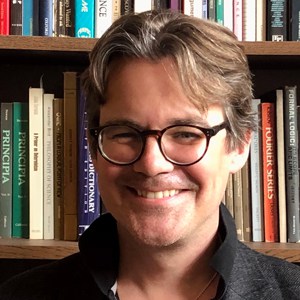Some years ago I was struck by the large number of falsehoods that I had accepted as true in my childhood, and by the highly doubtful nature of the whole edifice that I had subsequently based on them. I realized that it was necessary, once in the course of my life, to demolish everything completely and start again right from the foundations if I wanted to establish anything at all in the sciences that was stable and likely to last.
René Descartes
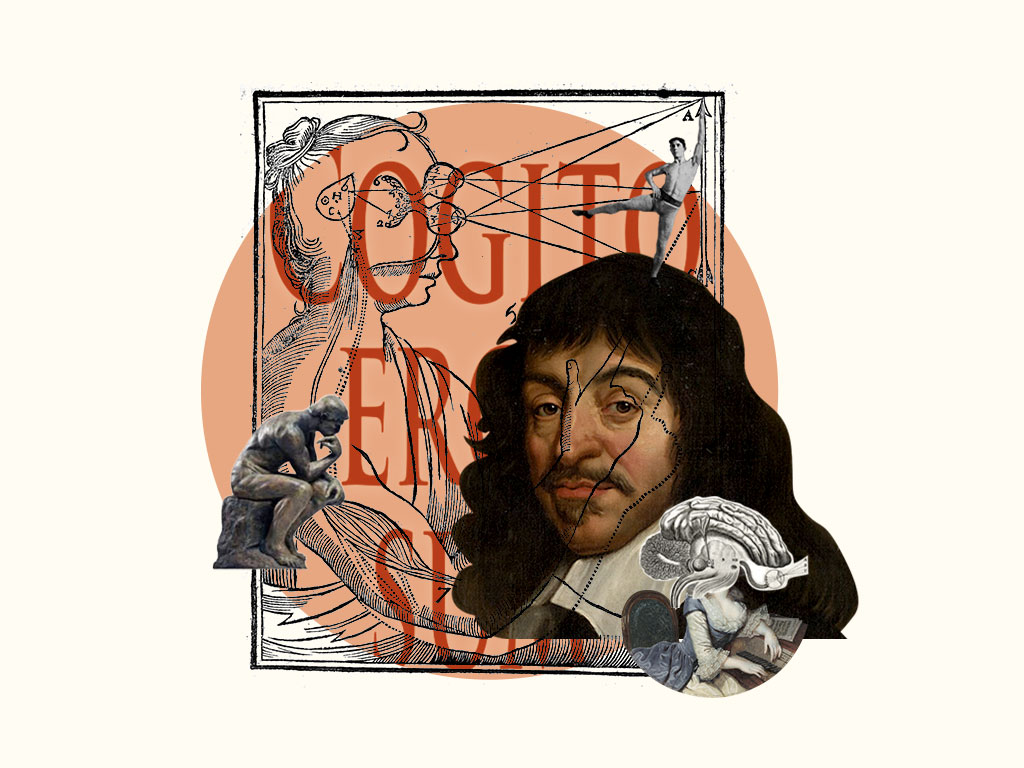
Meditations on First Philosophy
René Descartes
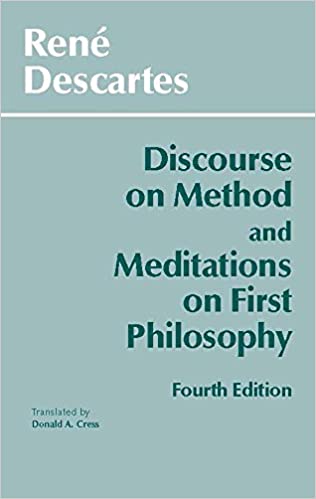
Cress, ISBN: 978-0872204201
In the "Meditations", Descartes invites the reader to meditate with him on the foundation of our knowledge.
Descartes begins by noting how riddled with error our house of knowledge is and so he decides to tear it down to the foundations in order to rebuild it. He proceeds to throw out any purported piece of knowledge that he can in any way doubt, and employs the device of an evil genie who is deceiving him about everything, including the truths of mathematics, to do so. What is finally left after all this doubt is his certainty of his own existence as a thinking thing, that is, a consciousness. This insight reveals to Descartes what all further knowledge must be like—it must be as clearly and distinctly perceived as his own self-awareness is. It is on the basis of this certainty of his own subjectivity that he rebuilds the world. After his self, he proves God’s existence by showing that we must have an idea of God and that this idea could not have possibly been produced by us, so therefore it must have been put there by a being as great or greater than our idea of God, namely, God itself. Finally, Descartes uses God to recover the world.
Why This Text is Transformative?
...Descartes sets the metaphysical foundation for the emerging physical sciences of the early modern period.
The Meditations, by Rene Descartes, is a pivotal text, marking the break between distinctive ancient and modern conceptions of self and world. In the preface to the work, addressed to the Sorbonne, Descartes explicitly states that his goal is to prove the existence of God and the soul. However, the world Descartes recovers after all his doubt is not the one we left behind. Colors are no longer in the object, but are relegated to mere secondary qualities in us. The bodies that inhabit this world are no longer understood through Aristotelian natures, but rather, their essence is captured by their mathematical (geometrical and arithmetical) properties and relations alone. In this way, Descartes sets the metaphysical foundation for the emerging physical sciences of the early modern period.
A Focused Selection
Study Questions
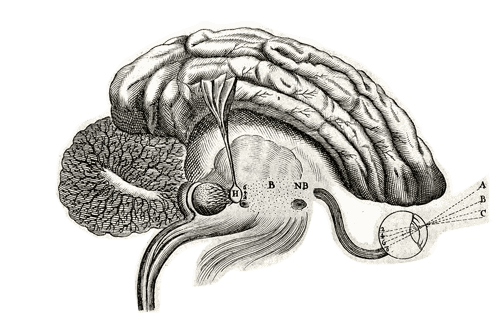
1) What are the reasons Descartes gives for doubting various things? Is there a way to know if you are dreaming from within the dream (i.e., without waking up)?
2) Analyze Descartes’s proof of God in the third meditation. How does it work? What are some problems with it?
3) Many people have claimed that Descartes’s use of clear and distinct ideas to prove that God exists, and then his use of God to underwrite the truth of what is clearly and distinctly perceived is circular (it’s referred to as the Cartesian Circle). Look at the fifth meditation and see if you think his reasoning is circular.
4) Since Plato, knowledge has been analyzed in terms of justified true belief. In the first meditation, Descartes decides that the criteria he will use as to whether he will hold on to a belief or reject it is whether it can be doubted. So beliefs have to be certain (indubitable) for Descartes to count them as knowledge. Is this a good criterion for knowledge? Why or why not? What criteria do you use when deciding whether you know something or not? Why do you use that one rather than a more or less strict principle?
Building Bridges
A Recommended Pairing
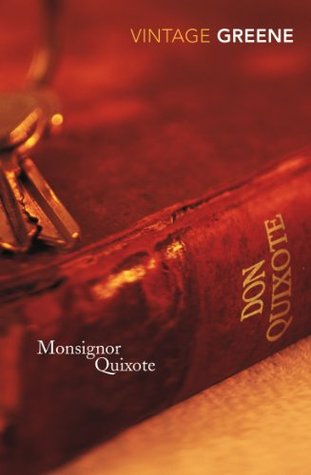
A wonderful short novel by Graham Greene, Monseigneur Quixote, recasts Cervantes’ magnum opus in a way that captures much of the humor and pathos in a more modern context, as the adventures of a Roman Catholic priest and a communist mayor taking to the road together in Spain during the Franco years. The richly imagined characters and their conversations make it clear that the issues that drive Don Quixote’s idealistic quest are not raised only in books of chivalry. How do we live with a commitment to the ideals of a religious faith or a political ideology which, though noble, may not fit easily with and may have unfortunate consequences in the unforgiving world in which we find ourselves? What difference does friendship make in our lives?
Supplemental Resources
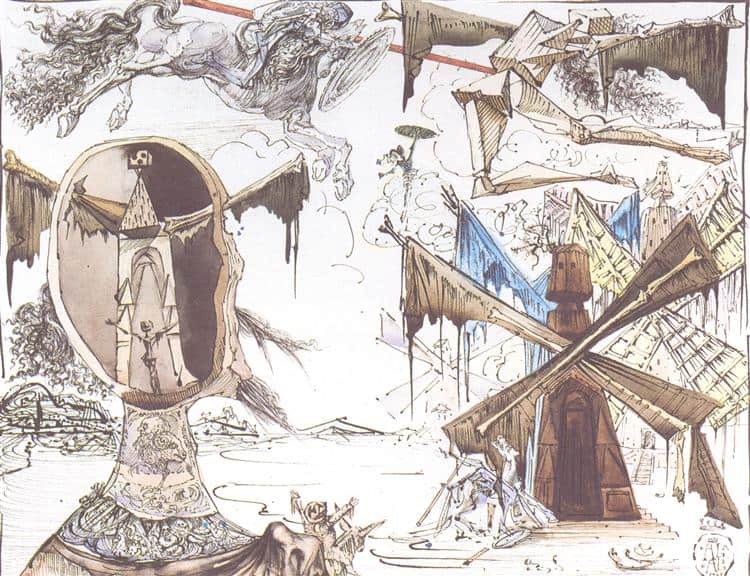
Don Quixote and the Windmills, 1945 - Salvador Dali - WikiArt.org
Don Quixote has been an inspiration for many visual artists. Spanish surrealist Salvador Dali returned to the novel multiple times throughout his long career, creating sketches, paintings, and sculptures of Don Quixote and Sancho, depicting important episodes in the book. A pairing of an episode with one of Dali’s works can lead to a stimulating discussion.
What details do students notice? What do his artistic choices suggest about his interpretation of the characters? To the extent that students are familiar with the story of Don Quixote, it is likely to be as it is filtered through the musical The Man of La Mancha. The musical has its own merits, and is framed by the interesting device of placing Cervantes on stage as a narrator, but of course it is impossible for it to capture much of the complexity of the book – and it alters the ending dramatically. Students may find it interesting to compare the two endings.
Text Mapping
Discipline Mapping
Psychology
Humanities
Philosophy & Religion
Page Contributor
